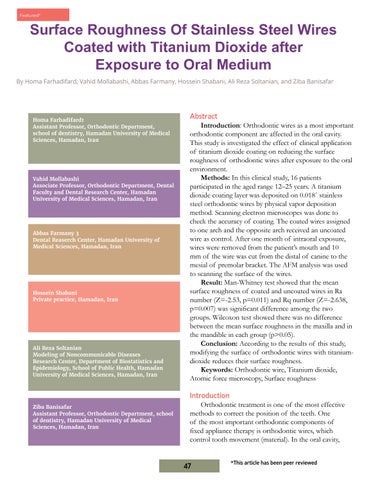Featured*
Surface Roughness Of Stainless Steel Wires Coated with Titanium Dioxide after Exposure to Oral Medium By Homa Farhadifard, Vahid Mollabashi, Abbas Farmany, Hossein Shabani, Ali Reza Soltanian, and Ziba Banisafar
Homa Farhadifard1 Assistant Professor, Orthodontic Department, school of dentistry, Hamadan University of Medical Sciences, Hamadan, Iran
Vahid Mollabashi Associate Professor, Orthodontic Department, Dental Faculty and Dental Research Center, Hamadan University of Medical Sciences, Hamadan, Iran
Abbas Farmany 3 Dental Reaserch Center, Hamadan University of Medical Sciences, Hamadan, Iran
Hossein Shabani Private practice, Hamadan, Iran
Ali Reza Soltanian Modeling of Noncommunicable Diseases Research Center, Department of Biostatistics and Epidemiology, School of Public Health, Hamadan University of Medical Sciences, Hamadan, Iran
Ziba Banisafar Assistant Professor, Orthodontic Department, school of dentistry, Hamadan University of Medical Sciences, Hamadan, Iran
Abstract Introduction: Orthodontic wires as a most important orthodontic component are affected in the oral cavity. This study is investigated the effect of clinical application of titanium dioxide coating on reducing the surface roughness of orthodontic wires after exposure to the oral environment. Methods: In this clinical study, 16 patients participated in the aged range 12–25 years. A titanium dioxide coating layer was deposited on 0.018΄ stainless steel orthodontic wires by physical vapor deposition method. Scanning electron microscopes was done to check the accuracy of coating. The coated wires assigned to one arch and the opposite arch received an uncoated wire as control. After one month of intraoral exposure, wires were removed from the patient’s mouth and 10 mm of the wire was cut from the distal of canine to the mesial of premolar bracket. The AFM analysis was used to scanning the surface of the wires. Result: Man-Whitney test showed that the mean surface roughness of coated and uncoated wires in Ra number (Z=-2.53, p=0.011) and Rq number (Z=-2.638, p=0.007) was significant difference among the two groups. Wilcoxon test showed there was no difference between the mean surface roughness in the maxilla and in the mandible in each group (p>0.05). Conclusion: According to the results of this study, modifying the surface of orthodontic wires with titaniumdioxide reduces their surface roughness. Keywords: Orthodontic wire, Titanium dioxide, Atomic force microscopy, Surface roughness Introduction Orthodontic treatment is one of the most effective methods to correct the position of the teeth. One of the most important orthodontic components of fixed appliance therapy is orthodontic wires, which control tooth movement (material). In the oral cavity, 47
47
*This article has been peer reviewed






















